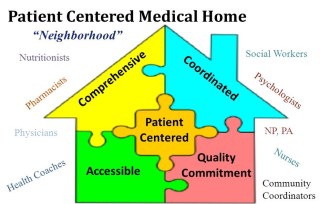Why should you care?

Many hospitals try to create an environment they call “Family-Centered Care” which is more a derivative of Patient-Centered Medical Home, a concept first introduced by the American Academy of Pediatrics (AAP) in 1967. At that time, it was envisioned as a central source for all the medical information about a child. It laid the groundwork for AAP’s policy statement in 1992 that defined a medical home as delivering family-centered, comprehensive, continuous and coordinated care that all infants and children deserve. Technology helped meet the original definition of providing a central source for all medical information.
Through the years, organizations have been established, such as the Patient-Centered Medical Home (PCMH), to provide accreditation of what is now seen as the four-core functions of PCMH: accessible, comprehensive, longitudinal and coordinated care in the context of families and community. During the development of national healthcare act, Obama hoped the national healthcare act would embrace Family-Centered Medical Care saying he would “encourage and provide appropriate payment for providers who implement the model.” As we all know that never happened.
The challenges involved in facilitating the delivery of family-centered care increases as the complexity of patient needs increase. In addition, the patient’s preferences and their ability to organize their own care play a significant role. Increases in complexity may overwhelm informal coordinating functions requiring a care team that can explicitly provide coordinated care and assume responsibility for the coordination of a particular patient’s care, according to PubMed Central an archived text at the U.S. National Institutes of Health’s National Library of Medicine (NIH/NLM). Why is this important to you? Because Here to Serve is the missing link!
While technology has helped organize and coordinate medical records, and in some cases medical care, what remains as challenges include: accessibility, comprehensive care, and “coordinated care in the context of families and community”; the last one is a BIG one!
Here to Serve is uniquely positioned to help families with what hospitals call “Family-Centered Care,” which is the fourth core function of PCMA, “coordinated care in the context of families and community.” We are excited about how we have been able to serve families with family-centered care with the help of a community of supporters. At the same time, we are acutely aware we are not widely used due to numerous factors, but these three are the biggest:
- Hospital social workers, who must juggle conflicting priorities including a heavy case load of low-income/poverty-level patients who require government assistance programs, are not focused on helping private insurance patient families.
- With social workers NOT focused on patients who have private insurance, referrals are not being made to patient families who could use Here to Serve services.
- Inexperience of patient families who have a child diagnosed with cancer causes them to overlook resources. What results is the complexity of home care overwhelms informal coordinating functions of patient families becomes apparent well into the journey. They start the journey thinking they can rely only on friends and family, or themselves, many of whom have never navigated this journey and do not know what lies ahead.
Here are some concerning statistics if patient families choose to do this alone:
- According to the Department of Health and Human Services, during any given year:
- 59% of informal caregivers have jobs in addition to caring for another person. Because of time spent caregiving, more than half of employed women caregivers show
- are more likely to be have symptoms of depression or anxiety
- are more likely to have a long-term medical problem, such as heart disease, cancer, diabetes, or arthritis
- have higher levels of stress hormones
- spend more days sick with an infectious disease
- have a weaker immune response to the influenza, or flu, vaccine
- have slower wound healing
- have higher levels of obesity
- may be at higher risk for mental decline, including problems with memory and paying attention
- have a 63% higher risk of mortality than others, even when adjusted for chronic disease and other risk factors.
- 59% of informal caregivers have jobs in addition to caring for another person. Because of time spent caregiving, more than half of employed women caregivers show
If you know someone who has a child recently diagnosed with cancer, help them understand this is a complex journey and even national health organizations, healthcare professionals, hospitals, and the government have not figured it out. Don’t let them make this journey without the help of Here to Serve to assist their friends, family and the community at large to bring family-centered help to their homelife. Use the GET HELP button to request our services!




